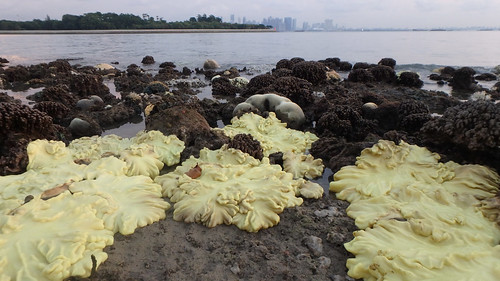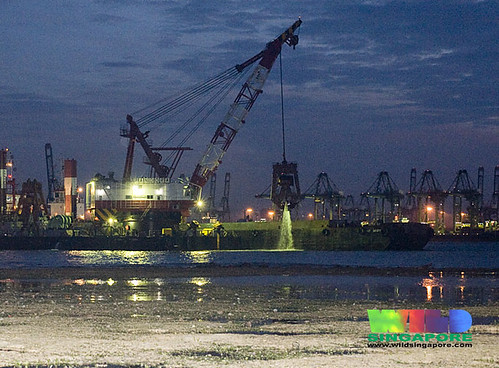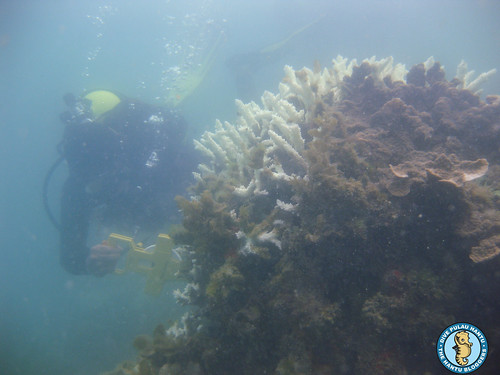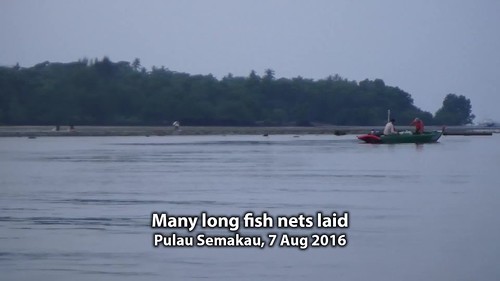Since June, the intertidal survey team has seen mass coral bleaching on 25 intertidal reefy shores. From our remote southern most reef at Raffles Lighthouse, to our northern most reef at Beting Bronok off Pulau Tekong. From the massive encrustation of corals on 2km of seawall at East Coast Park, to reefs on Kusu Island just minutes from the Central Business District. Even the reefs on natural Pulau Semakau next to the landfill and opposite petrochemical plants on Pulau Bukom.
From Mass coral bleaching in Singapore: why should I care? on wild shores of singapore blog.
Singapore has amazing coral reefs! Sadly, they are turning white -- ‘bleaching’. As are many other reefs around the world, such as the gianormous Great Barrier Reef. What’s going on? And why should we care?
 |
| Mass coral bleaching on natural Pulau Semakau, next to Singapore’s only landfill and opposite petrochemical plants on Pulau Bukom, Jul 2016 |
Probably. We found mass coral bleaching at 25 intertidal reefy shores (field notes of each survey here). But we could not survey the remaining 10 reefy intertidal locations (not enough low tide windows and no permissions). These 10 locations are likely to have suffered mass coral bleaching too, as we have seen mass coral bleaching or bleaching was reported there in the past. Our surveys do not cover subtidal reefs; these can only be surveyed by divers.
Our drone video of mass coral bleaching at Terumbu Pempang Tengah Jul 2016, screen shot below, shows the shocking extent of bleaching on some shores.
When did mass coral bleaching start in Singapore?
We first saw mass coral bleaching in June.
When will mass coral bleaching end in Singapore?
Our recent surveys suggest bleaching appears to be easing in August. But permanent recovery depends on whether temperatures fall and stabilise. The intertidal team had to suspend surveys for now as low tide windows will not resume until late October.
So what is coral bleaching? Why should I care?
What is a coral anyway?
Animal, vegetable or mineral? A coral is all of the above! See this video for more.
Corals have a special relationship with a tiny ‘plant’ -- symbiotic algae called zooxanthellae (let’s call them ‘zooks’!). This relationship makes coral reefs the rainforest of the sea.
With ‘zooks’, corals can make food from sunlight (this is why most corals do best in clear water and murky water hurts them). With ‘zooks’, corals can make hard skeletons that create habitats for fish and other plants and animals. Singapore’s reefs are home to spectacular marine creatures like wild dolphins and sea turtles!
 |
| Indo-Pacific humpbacked dolphin spotted near the Sisters Islands Marine Park in Aug 2016, photo by Stephen Beng. |
It is ‘zooks’ that give the corals their colours. When a coral is stressed, it loses its ‘zooks’ and turns transparent, the white skeleton showing through. Thus the coral colony appears white and ‘bleached’. But the coral is still alive.
If the stress ends, the coral can reabsorb ‘zooks’ from the surrounding water, regain its colour and health. However, if the stress continues, a coral without ‘zooks’ may grow weak and succumb to diseases and die.
 |
| In this photo, there are coral colonies that are bleaching (white), still healthy and not bleaching (brown), and recently dead (covered with light scummy growth). Pulau Semakau, Jul 2016. |
A single coral may bleach if it is stressed, and this is usually of little concern.
But many corals bleaching at the same time -- mass coral bleaching -- is a sign of widespread stress. An increase in sea surface temperatures of 1-2 degrees for a few weeks can trigger mass coral bleaching. Is it any wonder? We feel really sick when we have a fever of 1-2 degrees, even for a few hours!
Which marine life are affected by mass coral bleaching?
In our surveys, we noticed that some species of hard corals were among the first to bleach. Among them (clockwise from left) Cauliflower coral, Brain coral, Merulinid coral, Flowery disk coral, Trumpet coral, Carnation coral, Merulinid coral, Mushroom corals. Other species of hard corals bleached later or even hung on without bleaching. Many tiny animals live in and under corals. They too are hurt when corals become sick.
Leathery soft corals and Flowery soft corals were also among the first to bleach.
 |
| Large leathery soft coral bleaching opposite the Central Business District on Kusu Island, Jul 2016 |
Giant clams also have ‘zooks’. Fortunately, the clams we encountered during our surveys were not bleaching. Their fleshy bodies were still colourful with ‘zooks’. Like this beautiful one at Terumbu Pempang Laut, Aug 2016. But sadly, Dr Neo Mei Lin our giant clam expert, recently observed bleaching among the giant clams she is raising in the lab. Read her blog post to find out more about how bleaching impacts giant clams.

What causes mass coral bleaching? What is the role of climate change?
Devastating world wide mass coral bleaching was declared in October 2015, eight months before it first happened in Singapore, by the US National Oceanographic and Atmospheric Administration (NOAA). The third global mass coral bleaching event in recorded history, scientists warned it could result in the biggest global coral die-off. The only two previous such global events were in 1998 and 2010, when every major ocean basin experienced bleaching. Singapore’s reefs also suffered mass coral bleaching then.
 |
| Bleaching outlook by NOAA in May for Jun-Sep 2016 |
As bleaching events occur more frequently and closer together, corals have no time to recover. Some scientists believe that continued global temperature rise would lead a point when every year is a bleaching year by around 2030. This may lead to complete global loss of coral reefs by the middle of this century,
Other factors driven by climate change, such as ocean acidification, are also stressing corals to the point that scientists say, decades from now, reef communities will look and function much differently than they do today.
What’s good about mass coral bleaching?
Our corals are really obvious when they bleach white! It is only at this time that we can appreciate just how many corals we have on our shores. Also, this is when we often notice the corals growing in unlikely places such as the seawalls at ferry terminals.
 |
| From Terumbu Semakau, we could see corals bleaching across the narrow channel, on Pulau Semakau, Jul 2016 |
Mass coral bleaching is also a wake up call. To remind us that as the climate changes, the things we take for granted may change too. That we are a part of the problem, and thus, we can be a part of the solution.
What’s bad about mass coral bleaching?
Healthy reefs (together with other marine ecosystems like seagrasses and mangroves) maintain good water quality. As ecosystems falter and water quality deteriorates, we face risks such as Harmful Algal Blooms which can devastate aquaculture, kill marine life and harm or even kill humans. How much reefs do we need to lose before we get to such a dire state? I prefer not to find out.
An 'ecosystem' is a system of interactions among living organisms, and with non-living things such as sunlight, air, water, soil minerals. The living and non-living parts of this 'system' are connected through cycles of nutrients and energy flows (beginning from sunlight), as well as other kinds of relationships. An ecosystem is a system. Much like a car is a system. How many things can we damage or remove from a car before it stops working? Sometimes, losing one small thing (e.g., spark plug) can cause the car to break down.
This is why massive damage to an ecosystem such as mass coral bleaching is of great concern.
 |
| Mass coral bleaching on Big Sisters’ Island: on the horizon, Small Sisters’ Island and the skyline of the Central Business District, Jun 2016 |
Reefs provide shelter and food for important fisheries. No reefs, no fish. While Singapore may not rely on our reefs for fishes, fisheries are vital to other countries in our part of the world. Recently, there has been conflict in our neighbourhood over fisheries and ocean resource rights. As reefs die, contract and change, such issues can only worsen.
 |
| From "One of the World's Biggest Fisheries Is on the Verge of Collapse" National Geographic News 29 Aug 16. |
What can we do about mass coral bleaching?
Once corals bleach, there is nothing much that humans can do to help them. However, we can do our part to minimise other stresses on reefs so corals are in better health to cope with bleaching and recover quickly.
The continued presence of reefs in Singapore, even close to highly industrialised areas such as petrochemical plants, shows that agencies and corporations have done some things right. Our water quality remains good enough, and trash levels in the south are not as bad as in the north.
 |
| Rich reef on natural Pulau Semakau next to the landfill and opposite petrochemical plants on Pulau Bukom, Jul 2016 |
Reduce other stresses on reefs
But long before they bleach enmass, our reefs face many other pressures. These include unmanaged and relentless netting and trapping of fish and marine life.
Uncoordinated coastal works which may contribute to murky waters that hurt ‘zooks’ and their coral hosts
 |
| Dredging right next to Cyrene Reef, Jul 2011 |
 |
| This large dive boat ran aground on Terumbu Hantu, Nov 2014. |
Work together!
There is a growing community of ordinary people who care about our reefs and marine heritage. Divers, intertidal explorers, fishing enthusiasts, boaters, kayakers and others who simply love the water and our wildlife. Working together, agencies and communities can do great things for our beloved reefs.
Do science!
Mass coral bleaching is also an unintended experiment, and scientists and agencies are now probably gathering great data. To find out whether and where corals are spared from mass coral bleaching or have recovered more quickly, and learn why this is so. This will help us learn which sites in Singapore are the best for marine life, and the factors that create such conditions. Together with baseline data collected before mass coral bleaching, this can help us better protect Singapore’s marine heritage through conservation and restoration.
By developing expertise on coral bleaching and other coral health issues, Singapore’s reefs and the people who care for them can also contribute to regional reef conservation and restoration. We are after all, located near the Coral Triangle, the planet’s richest concentration of reefs!
You CAN make a difference for Singapore’s reefs: Explore, Express and Act
Explore and visit Singapore reefs and shores! From mainland reefs at East Coast Park to natural shores at Sentosa, and more adventurous shores on our Southern Islands. You can visit them at low tide, no need to swim, no need to dive. There are many guided walks to join, and more tips on visiting our shores.
 |
| Visitors join intertidal walks conducted by volunteers and NParks at the Sisters’ Islands Marine Park, Singapore’s first marine park. |
Express and share what you have seen and done on your social media channels. Speak up for our shores. Let me know if you have seen any mass coral bleaching, mass fish deaths or any other threats to our shores. Every shared sighting makes a difference!
ACT! Volunteer for our shores. From cleaning up the shores, to guiding at walks or dives, helping out with marine surveys, everyone’s time, talent and passion is welcomed. Here’s a list of some volunteer opportunities to consider.
 |
| Divers helping to monitor bleaching corals in Singapore. Photo by Debby Ng/Hantu Bloggers |
Singapore has awesome marine life, and even more amazing people who care about them. Come celebrate and conserve our shores together with us!




No comments:
Post a Comment